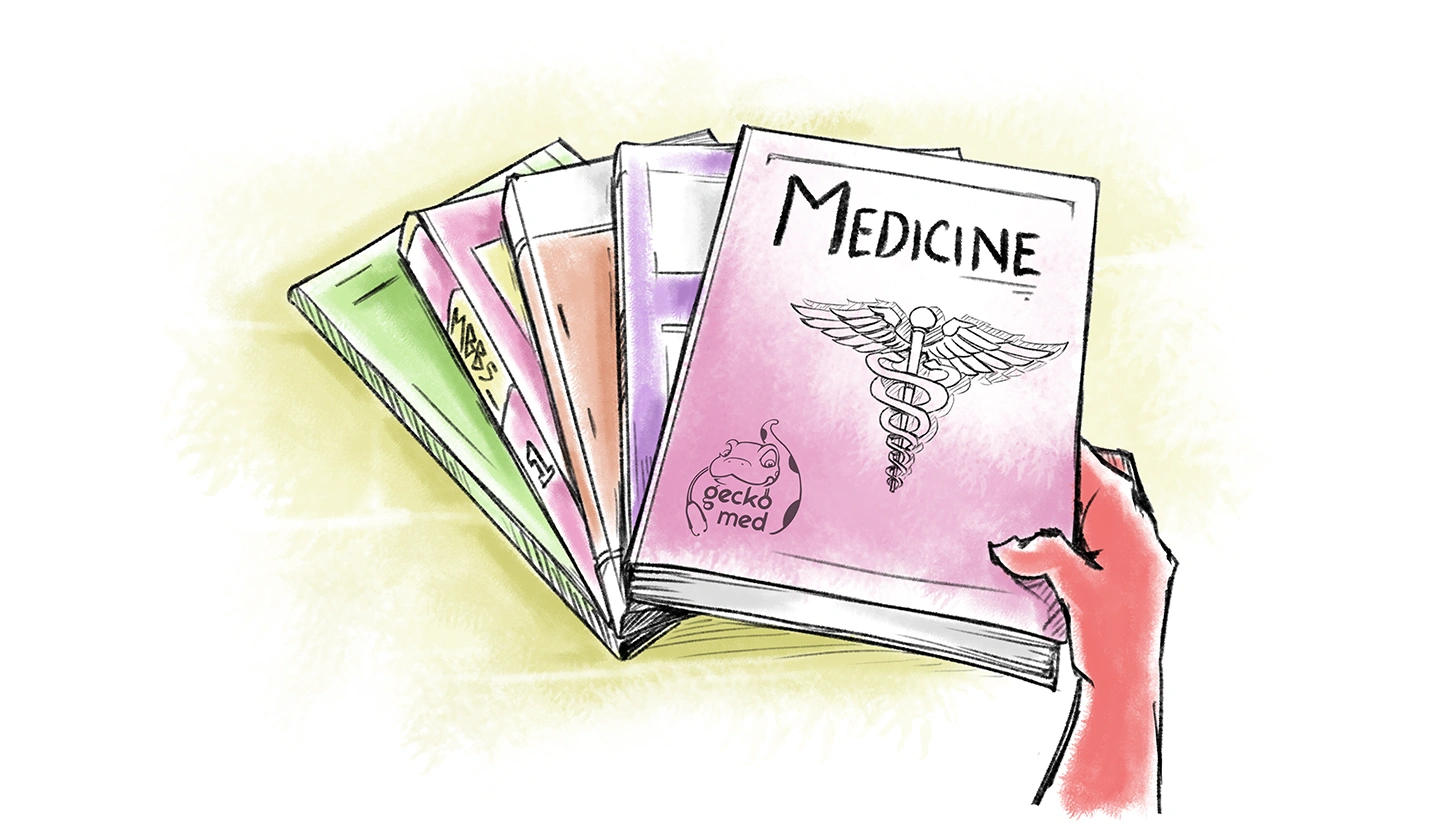MBBS students often face the challenge of finding the right resources to help them succeed in their studies.
With so many books available, it can be overwhelming to decide which ones are essential. We understand how important it is to have the right materials for effective learning.
This article provides a complete list of must-have medicine books for MBBS students. It will guide you through the best choices to enhance your understanding and performance in medical studies.
Medicine Books For MBBS: Pre-Clinical Subjects
The preclinical years of MBBS lay the groundwork for your medical knowledge. These years are dedicated to building a robust understanding of the human body’s structure, function, and biochemical processes.
Anatomy:
Anatomy, the study of the human body’s structure, is the bedrock of medical knowledge.
Mastering this subject requires a deep dive into the intricate details of organs, tissues, and their spatial relationships.
Here are some indispensable resources:
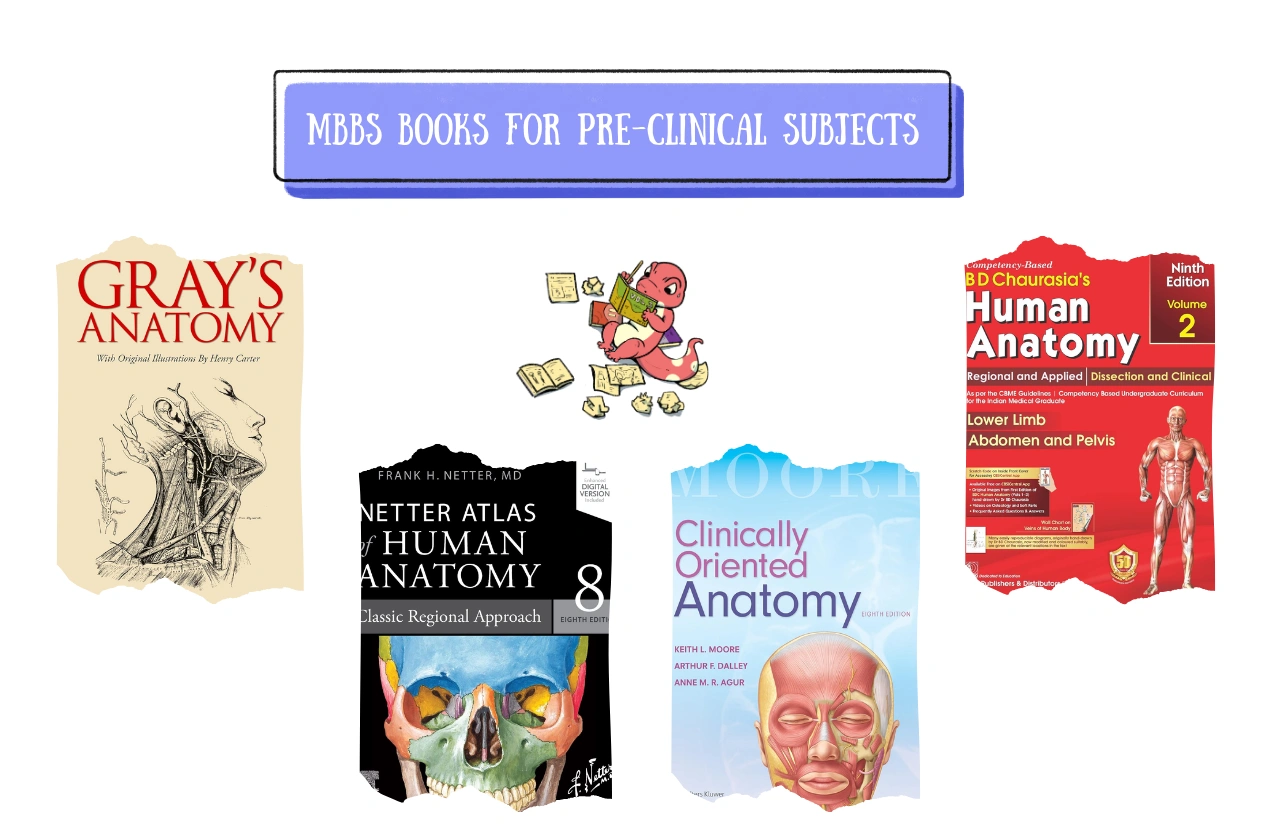
1) Gray’s Anatomy: A true titan in the realm of anatomical texts, Gray’s Anatomy reigns supreme for its comprehensive and meticulous exploration of the human body.
It’s available in various versions tailored to different needs:
- Gray’s Anatomy for Students: This edition caters specifically to the needs of medical students, presenting complex information in a clear and accessible manner with a strong emphasis on clinical relevance.
- Gray’s Atlas of Anatomy: This atlas complements the textbook with stunning visuals and detailed anatomical illustrations, making it an invaluable tool for visualizing complex structures and their interrelationships.
2) Netter’s Atlas of Human Anatomy: Renowned for its exquisite illustrations, Netter’s Atlas brings anatomy to life with vibrant and accurate depictions of the human body.
Its clear and concise labeling, coupled with a logical organization, makes it a favorite among medical students for visualizing and understanding anatomical structures.
3) Moore’s Clinically Oriented Anatomy: Bridging the gap between theoretical knowledge and clinical practice, Moore’s Clinically Oriented Anatomy emphasizes the practical applications of anatomical knowledge.
It effectively connects anatomical structures to their clinical significance, aiding in understanding the functional implications of anatomical variations and abnormalities.
4) BD Chaurasia’s Human Anatomy: A popular choice among medical students in India, BD Chaurasia’s Human Anatomy presents the subject in a clear, concise, and systematic manner.
Its simple language and comprehensive coverage make it a valuable resource for understanding the intricacies of the human body.
Tips for Mastering Anatomy:
- Visualize and Connect: Utilize the power of visual learning by combining atlases like Netter’s and Gray’s Atlas with textbooks like Gray’s Anatomy and Moore’s. This approach allows you to grasp the textual descriptions while simultaneously visualizing the structures, creating a more holistic understanding.
- Embrace Clinical Relevance: Don’t just memorize anatomical structures in isolation. Actively seek out the clinical relevance of each structure and its function. This will not only make your learning more engaging but also lay the groundwork for your clinical years.
- Hands-on Learning: Whenever possible, engage in hands-on learning experiences like anatomical dissections and the use of anatomical models. These activities provide a tangible understanding of spatial relationships and reinforce your theoretical knowledge.
- Spaced Repetition: Utilize spaced repetition techniques to reinforce your learning. Regularly revisit previously learned material to ensure long-term retention and combat the forgetting curve.
Physiology:
Physiology, the study of how the human body functions, is a cornerstone of medical understanding.
It delves into the intricate mechanisms that govern the body’s systems, from the cellular level to the integrated functioning of organs and organ systems.
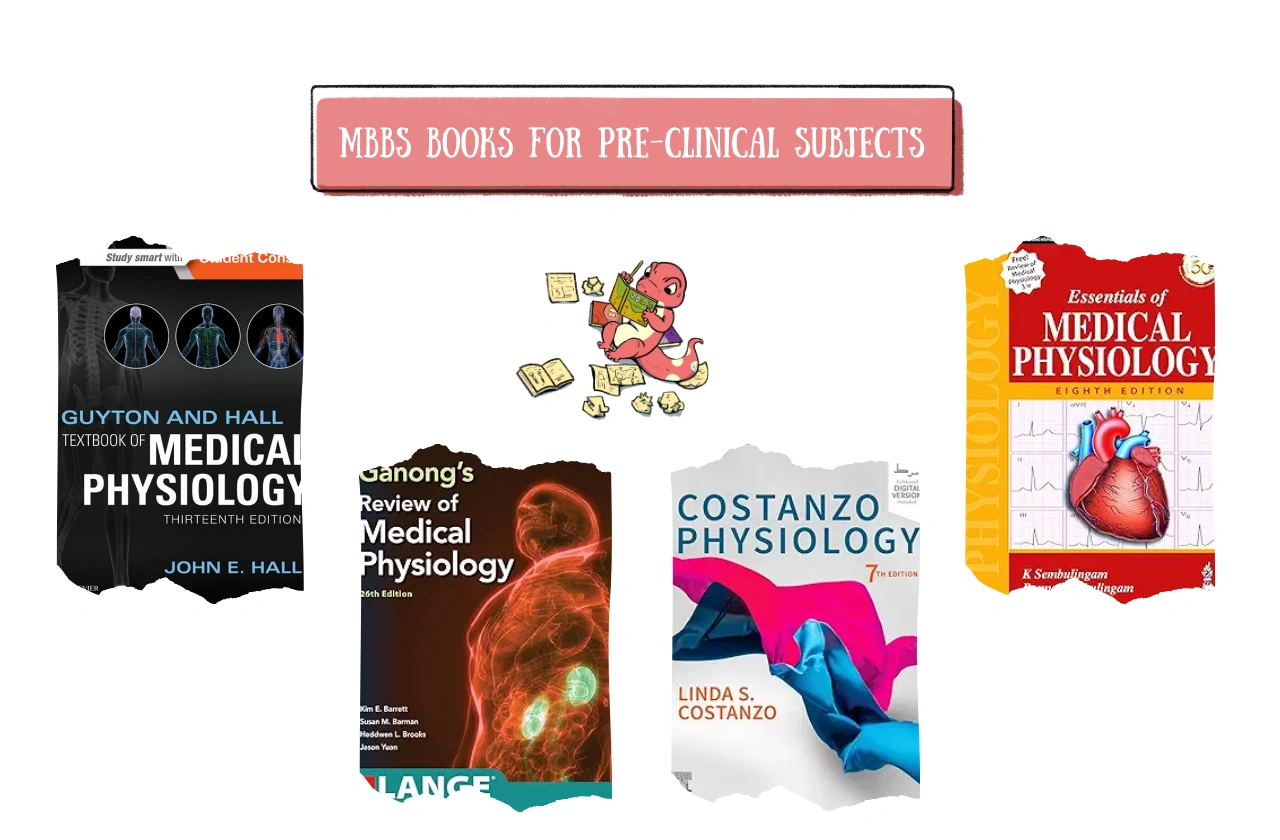
1) Guyton and Hall Textbook of Medical Physiology: A true authority in the field, Guyton and Hall’s Textbook of Medical Physiology provides an exhaustive and in-depth exploration of physiological principles.
Its clear explanations, supported by illustrative diagrams and clinical examples, make it a go-to resource for understanding the complexities of human physiology.
2) Ganong’s Review of Medical Physiology: Ideal for concise review and exam preparation, Ganong’s Review of Medical Physiology offers a focused and efficient approach to mastering key physiological concepts.
Its well-structured format and emphasis on high-yield information make it a valuable tool for consolidating your knowledge.
3) Costanzo Physiology: Presenting physiology in a clear and accessible style, Costanzo Physiology is a strong contender for those seeking a comprehensive yet approachable textbook.
Its emphasis on clinical relevance and integration of physiological concepts makes it a valuable resource for building a solid foundation in the subject.
4) Sembulingam’s Essentials of Medical Physiology: Widely used in India, Sembulingam’s Essentials of Medical Physiology provides a comprehensive and student-friendly overview of the subject.
Its clear language, concise explanations, and focus on essential concepts make it a valuable resource for navigating the complexities of human physiology.
Tips for Mastering Physiology:
- Conceptual Understanding over Rote Memorization: Focus on understanding the underlying principles and mechanisms rather than simply memorizing facts. Physiology is about grasping how the body works as an integrated system, not just recalling isolated details.
- Visualize with Flowcharts and Diagrams: Utilize flowcharts and diagrams to visualize physiological processes and their interconnections. This approach helps you understand complex pathways and interactions, making the learning process more intuitive and engaging.
- Relate to Clinical Scenarios: Connect physiological concepts to real-world clinical scenarios. This approach not only reinforces your understanding but also highlights the practical applications of physiological knowledge in diagnosing and managing diseases.
- Active Recall and Application: Test your understanding through active recall techniques like self-testing and explaining concepts to others. This helps solidify your knowledge and identify areas that require further review.
Biochemistry: Exploring the Molecular Basis of Life
Biochemistry delves into the chemical processes that underpin life itself.
It explores the intricate world of molecules, their interactions, and their roles in maintaining the body’s delicate balance.
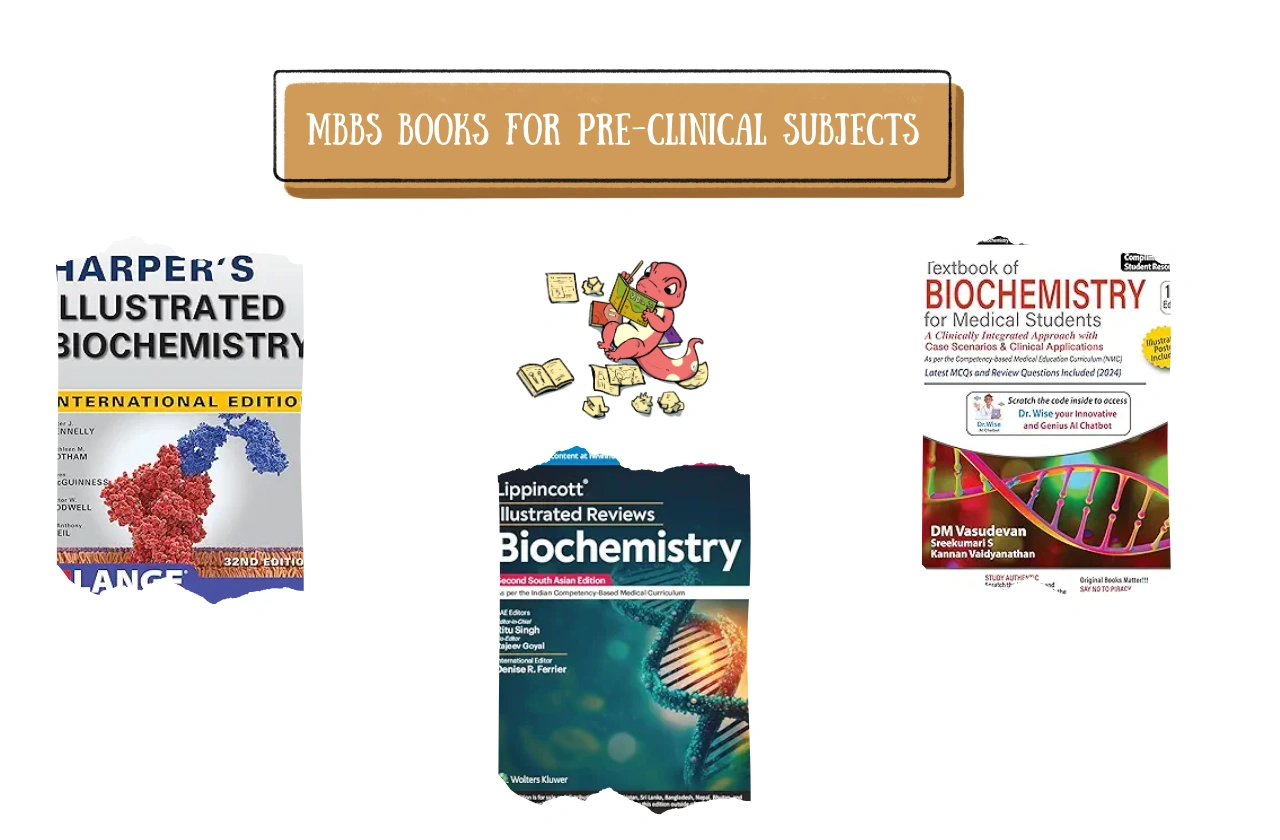
1) Harper’s Illustrated Biochemistry: A comprehensive and visually engaging text, Harper’s Illustrated Biochemistry provides a detailed exploration of biochemical principles.
Its clear explanations, complemented by numerous illustrations and clinical correlations, make it a valuable resource for understanding the molecular basis of health and disease.
2) Lippincott’s Illustrated Reviews: Biochemistry offers a concise yet comprehensive overview of key biochemical concepts.
Its visually appealing format, clinical correlations, and emphasis on high-yield information make it a valuable tool for consolidating your knowledge.
3) Vasudevan’s Textbook of Biochemistry for Medical Students: Popular among medical students in India, Vasudevan’s Textbook of Biochemistry provides a comprehensive and student-friendly approach to the subject.
Its clear language, concise explanations, and focus on essential concepts make it a valuable resource for navigating the complexities of biochemistry.
Tips for Mastering Biochemistry:
- Master Metabolic Pathways: Pay close attention to understanding metabolic pathways, as they form the foundation for understanding various diseases and their treatments. Utilize visual aids and online resources to visualize these complex pathways and their interconnections.
- Embrace Visual Learning: Utilize online resources like interactive diagrams and animations to visualize biochemical processes. These tools can bring abstract concepts to life, making them easier to understand and remember.
- Connect to Clinical Scenarios: Relate biochemical concepts to real-world clinical scenarios. This approach helps you appreciate the practical applications of biochemistry in diagnosing and managing diseases, making your learning more meaningful and relevant.
- Practice, Practice, Practice: Biochemistry requires consistent practice to solidify your understanding. Utilize practice questions, quizzes, and case studies to test your knowledge and identify areas that require further attention.
Let’s move on to the para-clinical subjects, which bridge the gap between basic sciences and clinical medicine.
Medicine Books For MBBS: Para-Clinical Subjects
The para-clinical years bridge the gap between pre-clinical sciences and clinical medicine.
They provide the crucial link between basic science knowledge and its application in understanding and managing diseases.
Pathology:
Pathology, the study of disease, delves into the causes, mechanisms, and effects of diseases on the human body.
It provides a critical foundation for understanding the nature of illness and its impact on various organ systems.
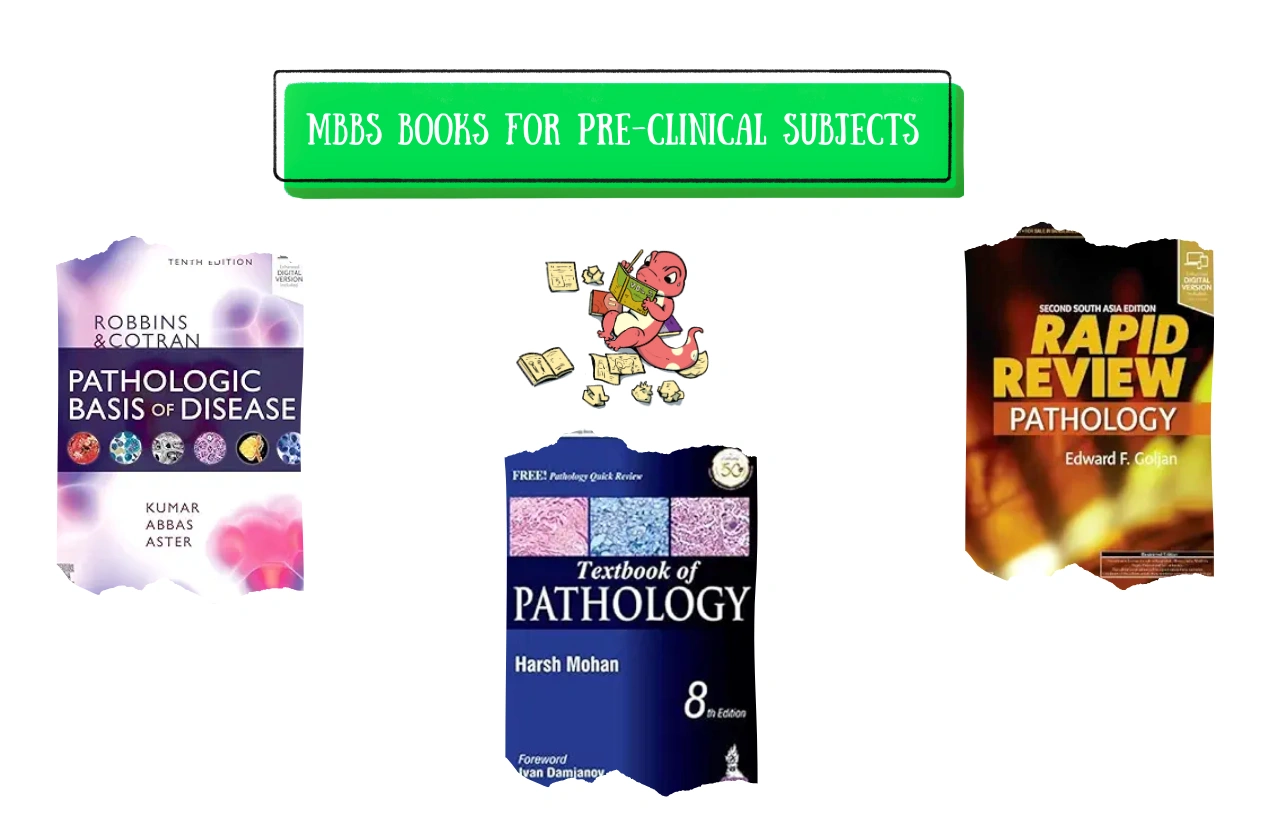
1) Robbins and Cotran Pathologic Basis of Disease: The undisputed cornerstone of pathology textbooks, Robbins and Cotran Pathologic Basis of Disease provides a comprehensive and in-depth exploration of disease processes.
Its clear and concise explanations, supported by high-quality images and clinical correlations, make it an indispensable resource for understanding the intricacies of pathology.
2) Harsh Mohan’s Textbook of Pathology: Widely used in India, Harsh Mohan’s Textbook of Pathology offers a clear and concise approach to the subject.
Its systematic presentation, comprehensive coverage, and focus on essential concepts make it a valuable resource for mastering pathology.
3) Goljan Rapid Review Pathology: Designed for efficient exam preparation, Goljan Rapid Review Pathology provides a concise and focused review of high-yield information.
Its concise format, emphasis on key concepts, and integration of clinical correlations make it a valuable tool for consolidating your knowledge and preparing for exams.
Tips for Mastering Pathology:
- Visualize with Images and Case Studies: Utilize the power of visual learning by incorporating images, microscopic slides, and case studies into your study routine. These tools bring pathology to life, allowing you to visualize disease processes and connect them to real-world scenarios.
- Integrate with Pre-clinical Knowledge: Connect your knowledge of anatomy, physiology, and biochemistry to understand the pathophysiological basis of diseases. This integrated approach provides a more holistic understanding of how diseases develop and manifest.
- Engage in Active Learning: Actively participate in discussions, case presentations, and clinical rotations to reinforce your understanding of pathology. This hands-on experience helps you connect theoretical knowledge to real-world clinical scenarios.
Pharmacology:
Pharmacology, the study of drugs and their interactions with the human body, is a critical subject for understanding how medications work and how to use them effectively in treating diseases.
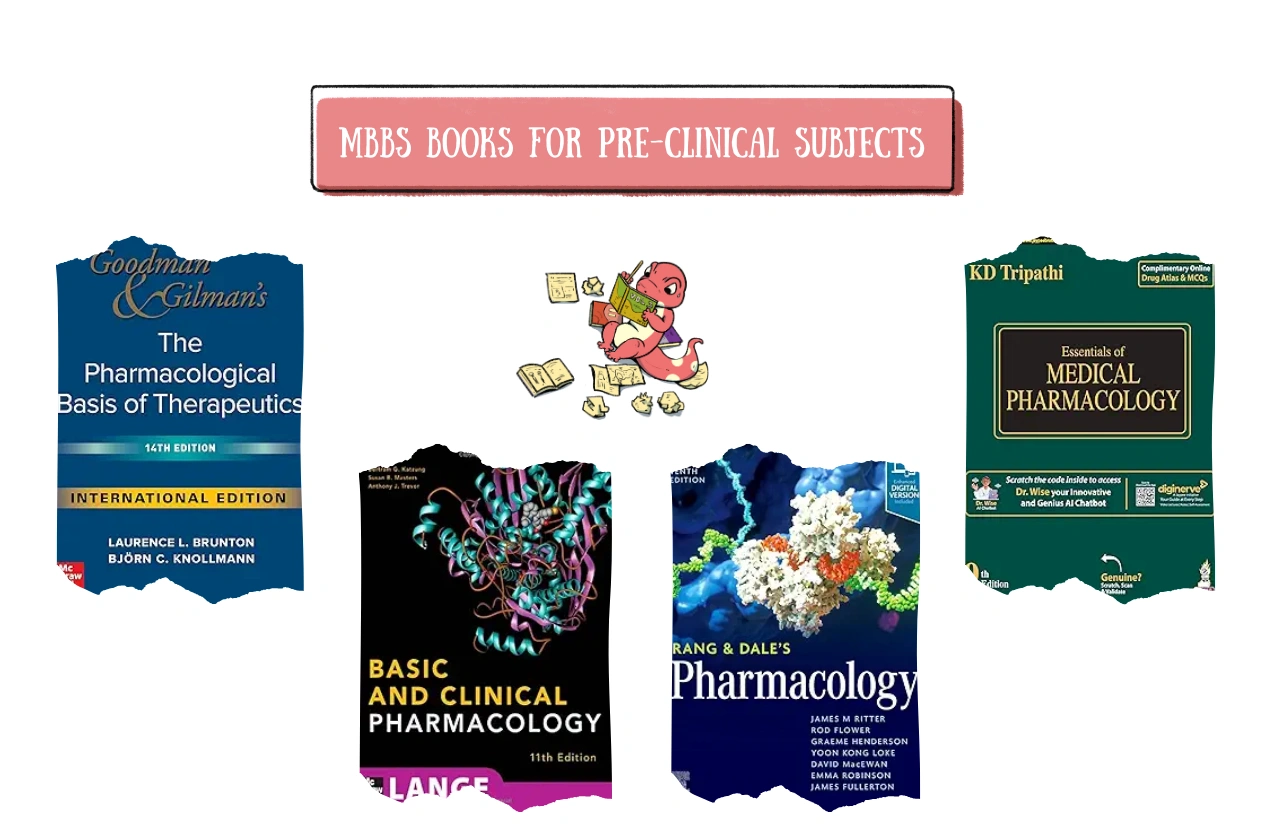
1) Goodman & Gilman’s The Pharmacological Basis of Therapeutics: A comprehensive and authoritative reference, Goodman & Gilman’s The Pharmacological Basis of Therapeutics provides an in-depth exploration of drug action and therapeutics.
Its detailed explanations, extensive coverage, and focus on molecular mechanisms make it an invaluable resource for understanding the complexities of pharmacology.
2) Katzung & Trevor’s Basic & Clinical Pharmacology: Widely used for its balanced approach, Katzung & Trevor’s Basic & Clinical Pharmacology effectively integrates basic science principles with clinical applications.
Its clear explanations, concise format, and emphasis on clinical relevance make it a valuable resource for mastering pharmacology.
3) Rang & Dale’s Pharmacology: A well-respected textbook known for its clear and concise presentation, Rang & Dale’s Pharmacology offers a comprehensive overview of the subject.
Its focus on essential concepts, supported by illustrative diagrams and clinical examples, makes it a valuable resource for understanding the principles of pharmacology.
4) KD Tripathi’s Essentials of Medical Pharmacology: Popular among medical students in India, KD Tripathi’s Essentials of Medical Pharmacology provides a comprehensive and student-friendly approach to the subject.
Its clear language, concise explanations, and focus on essential concepts make it a valuable resource for navigating the complexities of pharmacology.
Tips for Mastering Pharmacology:
- Focus on Mechanisms and Interactions: Pay close attention to understanding drug mechanisms of action and their interactions with the human body. This knowledge is crucial for safe and effective drug prescribing and for anticipating potential adverse effects.
- Utilize Mnemonics and Memory Aids: Employ mnemonics and memory aids to remember drug names, classifications, and their associated adverse effects. These tools can significantly enhance your ability to recall important pharmacological information.
- Stay Updated: Pharmacology is a dynamic field with constant advancements. Stay abreast of new drugs, updated guidelines, and emerging research to ensure your knowledge remains current and relevant.
Microbiology: Delving into the World of Microbes
Microbiology explores the fascinating world of microorganisms, including bacteria, viruses, fungi, and parasites.
Understanding these microscopic entities is crucial for diagnosing and managing infectious diseases.
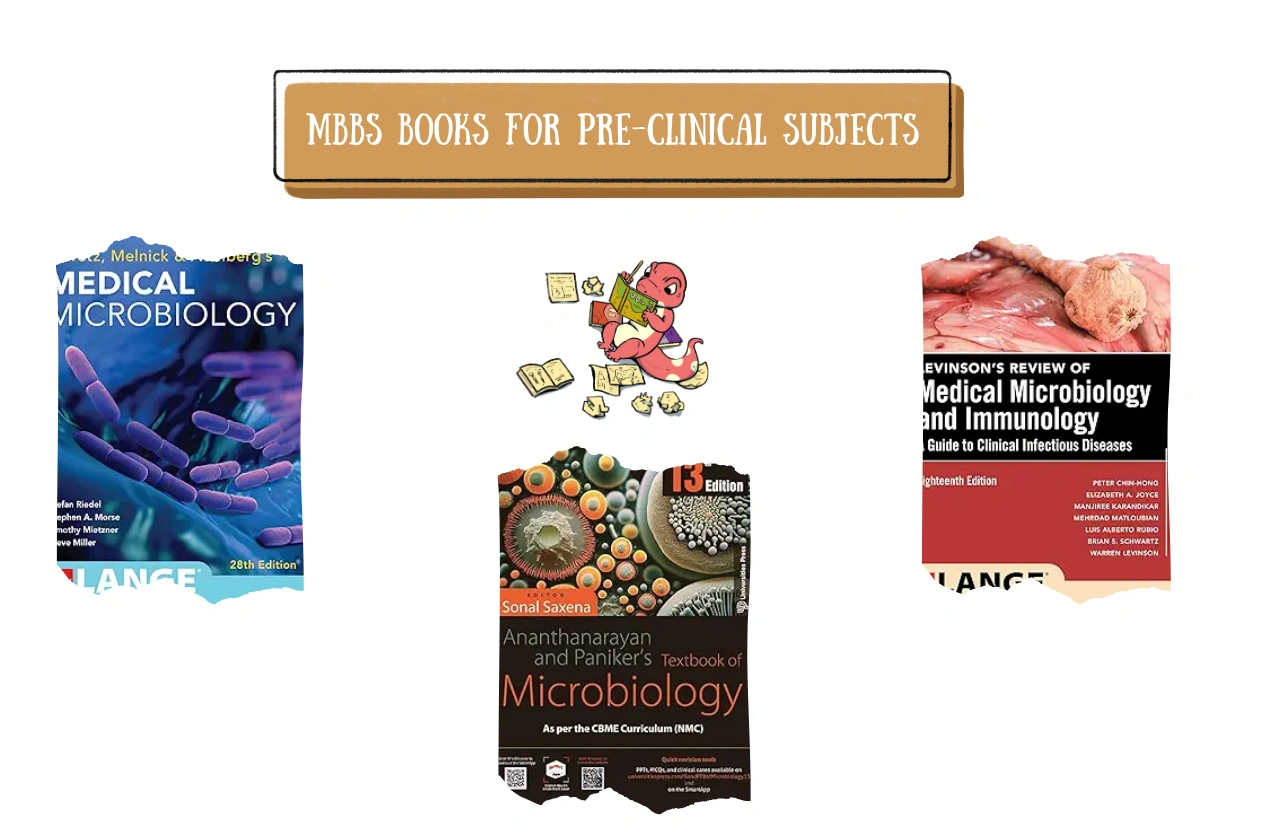
1) Jawetz, Melnick & Adelberg’s Medical Microbiology: A standard textbook in the field, Jawetz, Melnick & Adelberg’s Medical Microbiology provides a comprehensive overview of medical microbiology.
Its detailed explanations, extensive coverage, and focus on clinical relevance make it an invaluable resource for understanding the role of microorganisms in human health and disease.
2) Ananthanarayan and Paniker’s Textbook of Microbiology: Widely used in India, Ananthanarayan and Paniker’s Textbook of Microbiology offers a detailed and comprehensive account of microbiology with a strong emphasis on clinical aspects.
Its clear language, extensive coverage, and focus on regional infectious diseases make it a valuable resource for medical students in India.
3) Levinson’s Textbook of Microbiology and Immunology: Integrating microbiology and immunology, Levinson’s Textbook of Microbiology and Immunology provides a holistic understanding of host-pathogen interactions.
Its clear explanations, supported by illustrative diagrams and clinical correlations, make it a valuable resource for understanding the complexities of microbial infections and the body’s immune response.
Tips for Mastering Microbiology:
- Emphasize Clinical Relevance: Focus on understanding how microorganisms cause disease, their modes of transmission, and the principles of diagnosing and treating infections. This clinical perspective makes the study of microbiology more meaningful and relevant to your future medical practice.
- Utilize Mnemonics: Employ mnemonics to remember the characteristics of different microorganisms, their virulence factors, and associated diseases. These memory aids can significantly enhance your ability to recall important microbiological information.
- Stay Informed: Microbiology is a constantly evolving field with the emergence of new infectious diseases and drug-resistant strains. Stay informed about these developments to ensure your knowledge remains current and relevant.
Forensic Medicine & Toxicology:
Forensic medicine applies medical knowledge to legal issues, while toxicology deals with the effects of poisons and toxins on the human body.
These disciplines play a crucial role in legal investigations and public health.
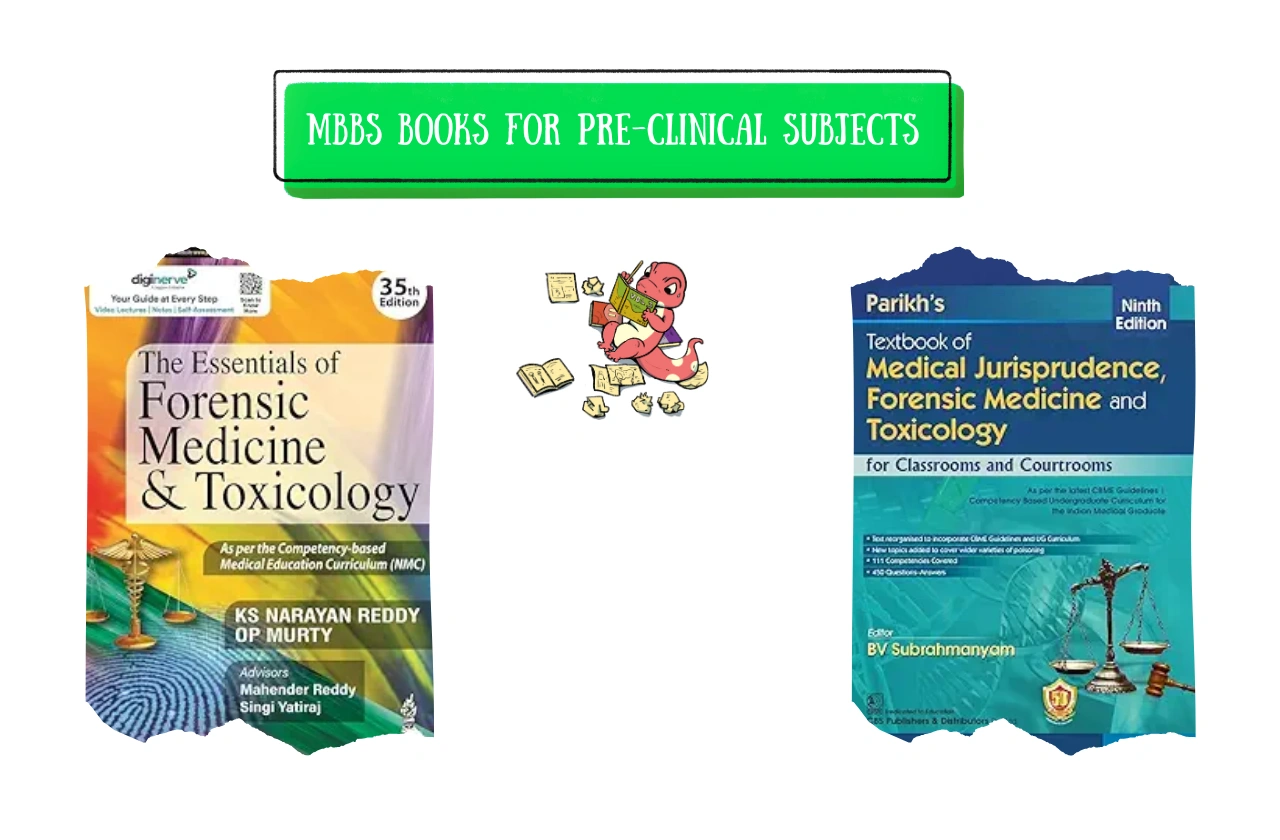
1) The Essentials of Forensic Medicine and Toxicology by K.S. Narayan Reddy: A standard text in the field, The Essentials of Forensic Medicine and Toxicology by K.S. Narayan Reddy provides a comprehensive overview of the subject.
Its clear explanations, extensive coverage, and focus on medico-legal aspects make it an invaluable resource for understanding the interface of medicine and law.
2) Parikh’s Textbook of Medical Jurisprudence, Forensic Medicine and Toxicology: Popular among medical students in India, Parikh’s Textbook of Medical Jurisprudence, Forensic Medicine and Toxicology offers a comprehensive and detailed account of the subject.
Its clear language, extensive coverage, and focus on Indian legal perspectives make it a valuable resource for medical students in India.
Tips for Mastering Forensic Medicine & Toxicology:
- Understand Legal Procedures: Focus on understanding legal procedures, medico-legal aspects, and ethical considerations related to medical practice. This knowledge is crucial for navigating medico-legal cases and ensuring ethical conduct in your medical career.
- Master Toxicological Principles: Develop a strong understanding of toxicological principles, including the mechanisms of action of poisons and toxins, their clinical manifestations, and the principles of managing poisoning cases. This knowledge is essential for providing timely and effective care in toxicological emergencies.
- Engage in Case Studies: Utilize case studies and real-world examples to reinforce your understanding of forensic medicine and toxicology. This approach helps you apply theoretical knowledge to practical scenarios and develop critical thinking skills in medico-legal contexts.
Now, let’s delve into the clinical subjects, which form the core of medical practice.
Medicine Books For MBBS: Clinical Subjects
The clinical years of MBBS mark the transition from classroom learning to patient care.
These years provide the opportunity to apply your accumulated knowledge and skills in real-world clinical settings, diagnosing and managing patients under the guidance of experienced clinicians.
General Medicine:
General medicine encompasses a vast spectrum of diseases affecting adults.
It forms the foundation of clinical practice, equipping you with the knowledge and skills to diagnose, manage, and provide comprehensive care to patients with various medical conditions.
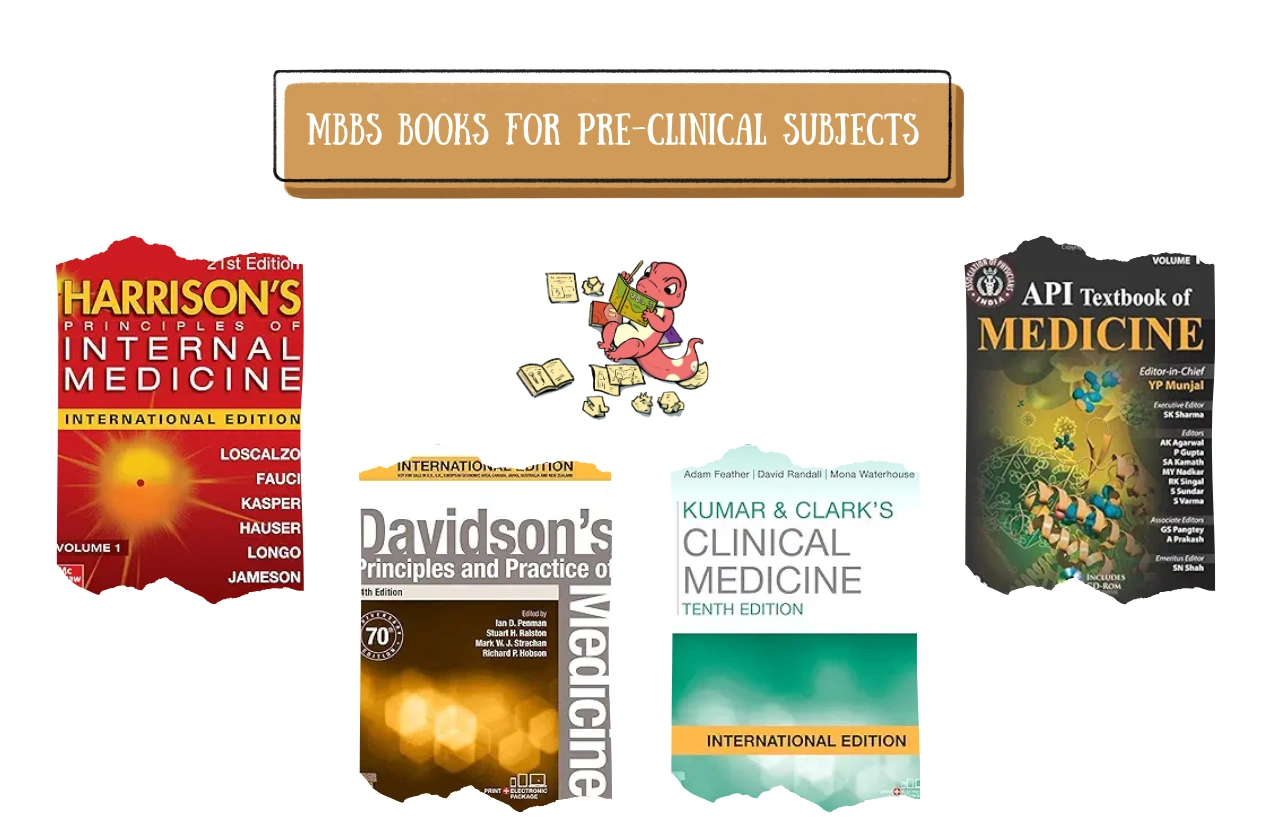
1) Harrison’s Principles of Internal Medicine: The undisputed authority in internal medicine, Harrison’s Principles of Internal Medicine provides comprehensive and in-depth coverage of all aspects of adult diseases.
Its clear explanations, extensive coverage, and focus on evidence-based practice make it an indispensable resource for any aspiring physician.
2) Davidson’s Principles and Practice of Medicine: A widely used alternative to Harrison’s, Davidson’s Principles and Practice of Medicine offers a concise and practical approach to internal medicine.
Its clear language, focus on essential concepts, and clinical orientation make it a valuable resource for mastering the core principles of internal medicine.
3) Kumar and Clark’s Clinical Medicine: Emphasizing clinical reasoning and decision-making, Kumar and Clark’s Clinical Medicine provides a practical approach to managing patients with various medical conditions.
Its case-based approach, clear explanations, and focus on clinical skills make it a valuable resource for developing your clinical acumen.
4) API Textbook of Medicine: Popular among medical students in India, the API Textbook of Medicine offers a comprehensive and detailed overview of internal medicine.
Its extensive coverage, focus on regional diseases, and contributions from leading Indian physicians make it a valuable resource for medical students in India.
Tips for Mastering General Medicine:
- Integrate Textbook Knowledge with Clinical Experience: Combine your textbook learning with active participation in clinical rotations, ward rounds, and patient interactions. This integrated approach allows you to apply theoretical knowledge to real-world scenarios and develop your clinical skills.
- Focus on Pathophysiology: Develop a strong understanding of the underlying pathophysiological mechanisms of diseases. This knowledge forms the basis for effective diagnosis, treatment, and management of medical conditions.
- Develop Clinical Reasoning Skills: Hone your clinical reasoning skills by analyzing case studies, participating in case discussions, and engaging in critical thinking exercises. This approach helps you develop the ability to synthesize information, formulate diagnosis, and devise appropriate treatment plans.
General Surgery:
General surgery involves the surgical management of a wide range of conditions affecting various organ systems.
It requires a unique blend of knowledge, skill, and judgment to provide effective surgical care to patients.

1) Bailey & Love’s Short Practice of Surgery: A classic text in general surgery, Bailey & Love’s Short Practice of Surgery provides a concise and practical overview of surgical principles and techniques.
Its clear language, extensive coverage, and focus on essential concepts make it a valuable resource for understanding the fundamentals of surgery.
2) Schwartz’s Principles of Surgery: A comprehensive and up-to-date resource, Schwartz’s Principles of Surgery covers all aspects of general surgery, from basic principles to advanced techniques.
Its detailed explanations, extensive coverage, and focus on evidence-based practice make it a valuable resource for mastering the complexities of surgical care.
3) Sabiston Textbook of Surgery: Another excellent option for a comprehensive understanding of surgical principles, Sabiston Textbook of Surgery provides in-depth coverage of surgical techniques, procedures, and patient management.
Its clear explanations, supported by high-quality images and clinical correlations, make it a valuable resource for mastering the art and science of surgery.
4) Manipal Manual of Surgery: Popular among medical students in India, the Manipal Manual of Surgery offers a practical and concise guide to surgical procedures.
Its focus on essential concepts, clear language, and step-by-step approach make it a valuable resource for understanding the practical aspects of surgical care.
Tips for Mastering General Surgery:
- Combine Textbook Learning with Observation: Complement your textbook learning with observation in the operating room. Witnessing surgical procedures first hand provides invaluable insights into surgical techniques, patient management, and the complexities of surgical decision-making.
- Focus on Surgical Anatomy and Techniques: Develop a strong understanding of surgical anatomy and the principles of surgical techniques. This knowledge forms the foundation for safe and effective surgical practice.
- Stay Updated on Advancements: Surgery is a constantly evolving field with continuous advancements in techniques, technologies, and procedures. Stay abreast of these developments to ensure your knowledge and skills remain current and relevant.
Obstetrics and Gynaecology:
Obstetrics deals with pregnancy, childbirth, and postpartum care, while gynaecology focuses on the female reproductive system and its associated disorders.
These disciplines require a unique blend of medical knowledge, surgical skills, and compassionate patient care.
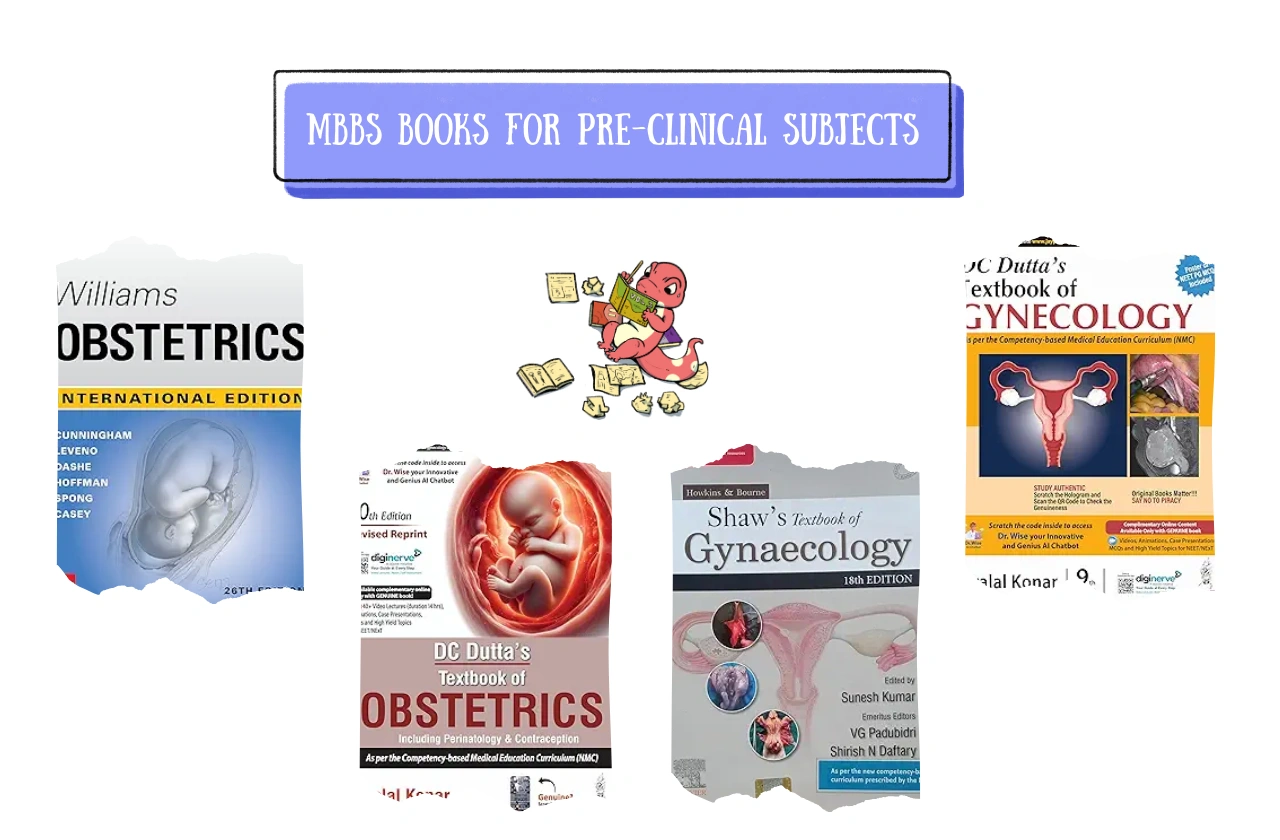
1) Williams Obstetrics: A leading textbook in obstetrics, Williams Obstetrics provides comprehensive coverage of pregnancy, childbirth, and postpartum care.
Its detailed explanations, extensive coverage, and focus on evidence-based practice make it an indispensable resource for understanding the complexities of maternal and fetal health.
2) Dutta’s Textbook of Obstetrics: Widely used in India, Dutta’s Textbook of Obstetrics offers a comprehensive and detailed overview of obstetrics.
Its clear language, extensive coverage, and focus on regional practices make it a valuable resource for medical students in India.
3) Shaw’s Textbook of Gynaecology: A standard text for gynaecology, Shaw’s Textbook of Gynaecology covers all aspects of female reproductive health, from common gynaecological conditions to complex surgical procedures.
Its clear explanations, supported by high-quality images and clinical correlations, make it a valuable resource for mastering the complexities of gynaecological care.
4) DC Dutta’s Textbook of Gynaecology: Popular among medical students in India, DC Dutta’s Textbook of Gynaecology provides a comprehensive and detailed overview of gynaecology.
Its clear language, extensive coverage, and focus on regional practices make it a valuable resource for medical students in India.
Tips for Mastering Obstetrics and Gynaecology:
- Integrate Knowledge from Various Disciplines: Integrate your knowledge of anatomy, physiology, pathology, and pharmacology to understand obstetric and gynaecological conditions. This integrated approach provides a holistic understanding of women’s health and the complexities of managing reproductive health issues.
- Focus on Clinical Skills and Communication: Develop strong clinical skills, including history-taking, physical examination, and communication skills. These skills are crucial for providing effective and compassionate care to women across their lifespan.
- Stay Updated on Guidelines and Best Practices: Obstetrics and gynaecology are dynamic fields with evolving guidelines and best practices. Stay informed about these developments to ensure your knowledge and skills remain current and relevant.
Pediatrics:
Pediatrics deals with the medical care of children, from infancy to adolescence.
It requires a specialized understanding of child development, growth, and the unique challenges of managing illnesses in children.
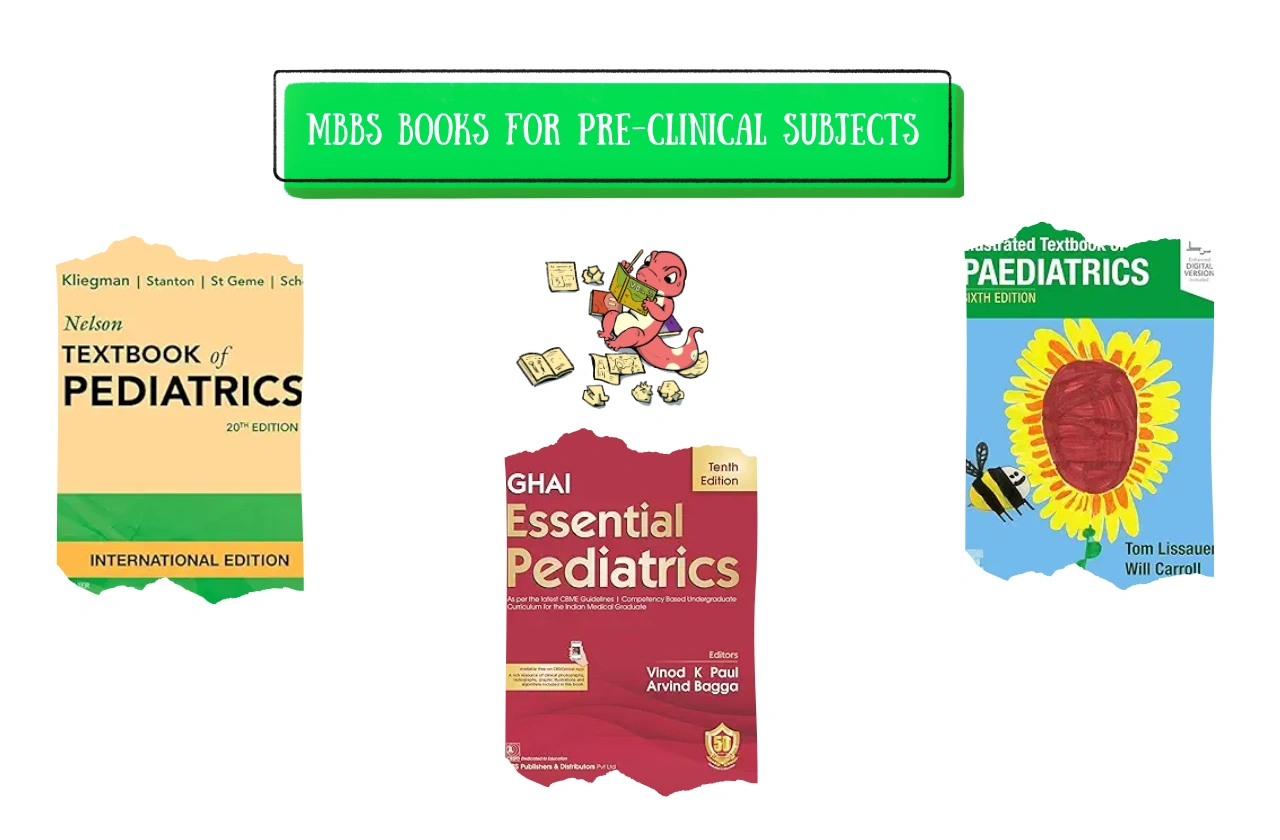
1) Nelson Textbook of Pediatrics: The most comprehensive resource in pediatrics, Nelson Textbook of Pediatrics covers all aspects of child health and diseases.
Its detailed explanations, extensive coverage, and focus on evidence-based practice make it an indispensable resource for understanding the complexities of pediatric care.
2) OP Ghai Essential Pediatrics: Popular among medical students in India, OP Ghai Essential Pediatrics offers a concise and practical approach to pediatrics.
Its clear language, focus on essential concepts, and clinical orientation make it a valuable resource for mastering the core principles of pediatric care.
3) Illustrated Textbook of Pediatrics by Tom Lissauer and Graham Clayden: A well-respected textbook known for its clear explanations and illustrative diagrams, the Illustrated Textbook of Pediatrics provides a comprehensive overview of pediatric medicine.
Its focus on clinical relevance, supported by case studies and practical tips, makes it a valuable resource for understanding the challenges of pediatric care.
Tips for Mastering Pediatrics:
- Understand Child Development: Develop a strong understanding of child development, growth milestones, and the physiological differences between children and adults. This knowledge is crucial for recognizing normal variations and identifying potential developmental delays or health concerns.
- Focus on Communication Skills: Hone your communication skills to effectively interact with children and their families. Building rapport and trust is essential for providing effective and compassionate pediatric care.
- Stay Updated on Pediatric Guidelines: Pediatrics is a dynamic field with evolving guidelines and best practices. Stay informed about these developments to ensure your knowledge and skills remain current and relevant.
Other Clinical Subjects:
In addition to the core clinical subjects, MBBS programs also cover a range of other specialties, each with its own set of essential textbooks.
Here are some key resources for these specialties:
- Ophthalmology: Parsons’ Diseases of the Eye provides a comprehensive overview of eye diseases and their management.
- ENT: Diseases of Ear, Nose and Throat & Head and Neck Surgery by PL Dhingra offers a detailed account of ear, nose, and throat conditions and their surgical management.
- Orthopedics: Campbell’s Operative Orthopaedics is a comprehensive resource for understanding orthopedic principles and surgical techniques.
- Dermatology: Fitzpatrick’s Dermatology in General Medicine provides a detailed exploration of skin diseases and their management.
- Psychiatry: Kaplan & Sadock’s Synopsis of Psychiatry offers a comprehensive overview of psychiatric disorders and their treatment.
To maximize the benefits of textbooks, it’s important to choose and use them effectively.
Tips for Choosing and Using MBBS Textbooks Effectively
Choosing the right textbooks is just the first step. To truly benefit from these valuable resources, you need to adopt effective study strategies and utilize them in a way that maximizes your learning.
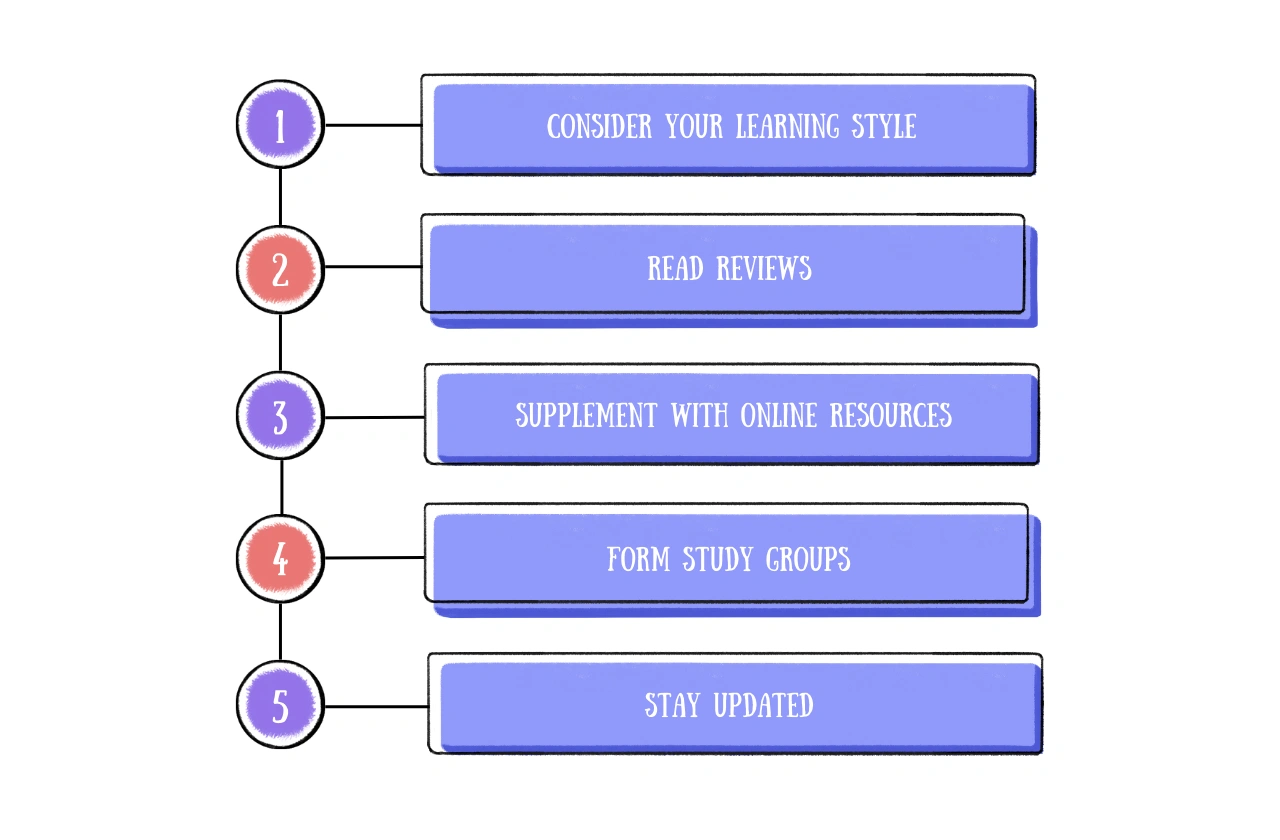
1) Consider Your Learning Style: Reflect on your learning preferences and choose textbooks that align with your style. Some students prefer concise texts with bullet points and summaries, while others prefer detailed explanations and in-depth discussions.
2) Read Reviews: Seek out reviews from other students and faculty to gain insights into the strengths and weaknesses of different textbooks. Online platforms and student forums can provide valuable perspectives.
3) Supplement with Online Resources: Enhance your learning with online resources such as medical websites, videos, online question banks, and interactive simulations. GeckoMed is one such tool that provides visual aids, reinforce concepts, and offer opportunities for self-assessment.
4) Form Study Groups: Engage in collaborative learning by forming study groups with your peers. Discussing concepts, explaining topics to each other, and working through practice questions together can significantly enhance your understanding and retention.
5) Stay Updated: Medicine is a constantly evolving field with new research, guidelines, and treatment modalities emerging regularly. Stay updated by referring to the latest editions of textbooks, attending conferences, and reading medical journals.
By following these tips, you can make the most of your textbooks and enhance your learning experience.
Conclusion
The journey through medical school is both challenging and rewarding. Choosing the right textbooks and utilizing them effectively is crucial for navigating this journey successfully.
This comprehensive guide provides a roadmap to the essential textbooks for MBBS students, offering insights and tips to help you make informed decisions and maximize your learning.
Remember to consider your learning style, read reviews, and use multiple resources to gain a well-rounded understanding of each subject.
Supplement your textbook knowledge with online resources, clinical experiences, and discussions with your peers.
With dedication, perseverance, and the right resources, you can successfully navigate the challenges of medical school and build a strong foundation for your future medical career.

